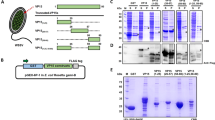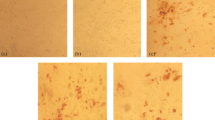Abstract
The gene encoding the VP28 envelope protein of White spot syndrome virus (WSSV) was cloned into expression vector pET-30a and transformed into the Escherichia coli strain BL21. After induction, the recombinant VP28 (rVP28) protein was purified and then used to immunize Balb/c mice for monoclonal antibody (MAb) production. It was observed by immuno-electron microscopy the MAbs specific to rVP28 could recognize native VP28 target epitopes of WSSV and dot-blot analysis was used to detect natural WSSV infection. Competitive PCR showed that the viral level was approximately 104 copies/mg tissue in the dilution of gill homogenate of WSSV-infected crayfish at the detection limit of dot-blot assay. Our results suggest that dot-blot analysis with anti-rVP28 MAb could rapidly and sensitively detect WSSV at the early stages of WSSV infection.
Similar content being viewed by others
References
Chaivisuthangkura P, Longyant S, Rukpratanporn S, et al. 2010. Enhanced white spot syndrome virus (WSSV) detection sensitivity using monoclonal antibody specific to heterologously expressed VP19 envelope protein. Aquaculture, 299: 15–20.
Chou H Y, Huang C Y, Wang C H, et al. 1995. Pathogenicity of a baculovirus infection causing white spot syndrome in cultured Penaeid shrimp in Taiwan. Dis Aquat Org, 23: 165–173.
Du H H, Fu L L, Xu Y X, et al. 2007. Improvement in a simple method for isolating white spot syndrome virus (WSSV) from the crayfish Procambarus clarkii. Aquaculture, 262: 532–534.
Du H H, Li W F, Xu Z R, Kil, et al. 2006. Effect of hyperthermia on the replication of white spot syndrome virus (WSSV) in Procambarus clarkii. Dis Aquat Org, 71: 175–178.
Du H H, Xu Z R, Wu X F, et al. 2006. Increased resistance to white spot syndrome virus in Procambarus clarkii by injection of envelope protein VP28 expressed using recombinant baculovirus. Aquaculture, 260: 39–43.
Durand S V, Redman R M, Mohney L L, et al. 2003. Qualitative and quantitative studies on the relative virus load of tails and heads of shrimp acutely infected with WSSV. Aquaculture, 216: 9–18.
Fauquet C M, Mayo M A, Maniloff J, et al. 2005. Virus Taxonomy. Classification and Nomenclature of Viruses. In: Eighth Report of the International Committee on Taxonomy of Viruses. San Diego: Elsevier Academic Press.
Inouye K, Yamano K, Ikeda N, et al. 1996. The penaeid rod shaped DNA virus (PRDV), which causes penaeid acute viremia (PAV). Fish Pathol, 31: 39–45.
Jaroenram W, Kiatpathomchai W, Flegel T W. 2009. Rapid and sensitive detection of white spot syndrome virus by loop-mediated isothermal amplification combined with a lateral flow dipstick. Mol Cell Probes, 23: 65–70.
Jiang Y S, Zhan W B, Sheng X Z. 2007. Neutralizing assay of monoclonal antibodies against white spot syndrome virus (WSSV). Aquaculture, 272: 216–222.
Jory D E, Dixon H M. 1999. Shrimp white spot syndrome virus in the western hemisphere. Aquaculture Magazine, 25: 83–91.
Makesh M, Koteeswaran A, Danel Joy, et al. 2006. Development of monoclonal antibodies against VP28 of WSSV and its application to detect WSSV using immunocomb. Aquaculture, 261: 64–71.
Otta S K, Karunasagar I, Karunasagar I. 2003. Detection of monodon baculovirus and white spot syndrome virus in apparently healthy Penaeus monodon postlarvae from India by polymerase chain reaction. Aquculture, 220: 59–67.
van Hulten M C, Witteveldt J, Peters S, et al. 2001. The white spot syndrome virus DNA genome sequence. Virology, 286: 7–22.
Wang Y Z, Zhang X H, Yuan L, et al. 2008. Generation of recombinant monoclonal antibodies to study structurefunction of envelope protein VP28 of white spot syndrome virus from shrimp. Biochem Biophy Res Communi, 372: 902–906.
Xie X, Xu L, Yang F. 2006. Proteomic analysis of the major envelope and nucleocapsid proteins of white spot syndrome virus. J Virol, 80: 10615–10623.
Yi G, Wang Z, Qi Y, et al. 2004. Vp28 of shrimp white spot syndrome virus is involved in the attachment and penetration into shrimp cells. J Biochem Mol Biol, 37: 726–734.
Author information
Authors and Affiliations
Corresponding author
Additional information
Foundation item: NSFC (30901116); Zhejiang Provincial Natural Science Foundation of China (Y3080212); The Planned Science and Technology Project of Zhejiang Province, China (2008C32034).
Rights and permissions
About this article
Cite this article
Hou, Cl., Cao, Y., Xie, Rh. et al. Characterization and diagnostic use of a monoclonal antibody for VP28 envelope protein of white spot syndrome virus. Virol. Sin. 26, 260–266 (2011). https://doi.org/10.1007/s12250-011-3202-0
Received:
Accepted:
Published:
Issue Date:
DOI: https://doi.org/10.1007/s12250-011-3202-0




